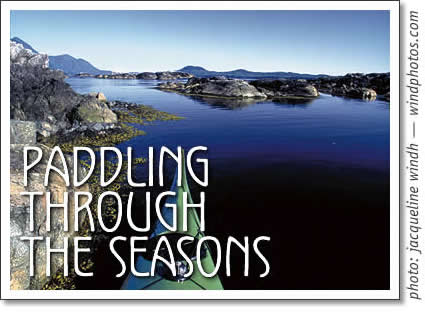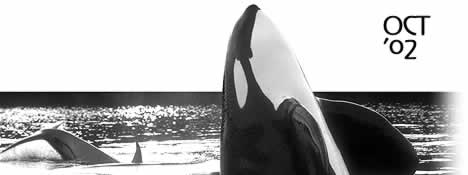
Tofino Kayaking: Paddling through the seasons
by Dan Lewis, Tofino

It's hard to miss if you've been paying attention. The shorebirds of Tofino have been heading south for almost two months as I write this. The green grasses of spring have turned gold, the sun's energy stored in the seeds. Let's face it, summer has peaked and begun to wane.Time to hang up the paddle…What? You haven't managed to get out yet? Fear not, gentle reader. With a few extra precautions, paddling can be a year-round activity here in Tofino on the West Coast. One of my favourite outings of the year is an annual trip to watch the return of spawning salmon to local streams. There is something about the sight of hundreds of fish milling about in a tiny creek, and the subsequent decay of their bodies that helps keep my internal calendar on track, reminding me of the transience of life, and the cycles of death and rebirth.
The chum salmon or dog salmon come in with the onset of fall rains, right around Thanksgiving (early October). They can be seen as late as November, but much later than that and any experience of chum will be mostly olfactory. Coho salmon come in a bit later, and can be seen through November, even past Christmas sometimes!
First you need to find out where your local salmon creeks are. If you don't know where to find salmon spawning, ask at a hatchery, or check with your local Streamkeepers group. People are often surprised to find out just how small a creek can provide spawning habitat. I've seen coho spawning in a ditch beside a 4-lane highway, after swimming through a culvert. Chum salmon will also spawn in very small creeks — you don't need a big river like the Fraser or Columbia.
My favourite spot is close to home, right here in Clayoquot Sound. You paddle halfway up Lemmen's Inlet, to Sharp Creek on Meares Island. Leave Tofino on a rising tide. It takes about an hour to get there, and an hour to get back, plus at least another hour to watch the fish. When you get to your chosen destination, park your kayak safely above the high water mark. Walk quietly along the banks, and be prepared to sit for some time if you wish to catch them in The Act. There is a lot of preliminary activity—you may see a female digging the nest (known as the redd) with her tail, moving a few cobbles each time, slowly creating a hole of sufficient depth. Meanwhile the male hovers nearby, usually right beside her and a bit downstream, with his nose abreast of her dorsal fin. He crosses over her back from side to side frequently, and will occasionally leave her side to chase away other males hoping to get in on The Act, or a cutthoat trout hoping to schnarf back a few eggs.
If you wait long enough, you may be fortunate enough to see a flurry of activity when the female deposits her eggs in the redd, while the male quivers beside her as he lets go his milt, some of which hopefully contacts and fertilizes the eggs, while the rest is swept downstream in a milky cloud. Right then the other males in the vicinity dart in, and the cutthroat snatch any stray eggs being swept downstream by the current.
The female moves upstream a bit, and begins again to push pebbles with her tail, this time allowing the current to bounce them down into the redd, filling it in. The fertilized eggs spend the winter buried in gravel, the waters of the creek bringing them life-sustaining oxygen. If you arrive too late to catch The Act, you may see a female or pair of salmon guarding the redd, which they do until their death some days later.
When the salmon spawning season is over, winter is an excellent time for waterfowl viewing. Which species you see will vary, depending on where you paddle. Many ducks which breed in summer on lakes in the Interior come down to the coast to over-winter on the ice-free waters. Species to watch for include Mallards, Buffleheads, Grebes (Western, Red-necked and Horned), Scoters (Black, Surf and White-winged), Mergansers (Common, Red-breasted, Hooded), Wigeons (American and Eurasian), Goldeneyes (Common and Barrow's), and Scaups (Greater and Lesser). If you're lucky, you may even see birds such as Oldsquaw, or Trumpeter Swans. And of course, many year-round residents can be sighted in winter, including Great Blue Herons, Belted Kingfishers, Bald Eagles, and Cormorants.
So how about those extra precautions? Be sure to check the marine weather forecast before heading out—the timing of salmon spawning coincides with the arrival of rain carried by the "pineapple express"— wave after wave of Pacific fronts with gale force south-easterlies. Good raingear is a must, as is warm pile, neoprene or woollen clothing. Energy snacks and a thermos of hot tea are a good idea, especially if you plan to sit watching wildlife for any length of time. Take a flashlight, and keep an eye on the time — sunset comes surprisingly early. And remember, there are fewer people out and about in the off-season — be prepared and self-sufficient. See you out there!
Dan Lewis lives and paddles year-round in Clayoquot Sound, where he operates Rainforest Kayak Adventures in Tofino. He can be reached at mail@rainforestkayak.com or call 1.877-422.WILD.
Tofino Kayaking Articles
- A Foggy Adventure May 2002
- Don't be a Speedbump July 2002
- Excursion to Flower Rock April 2003
- Kayak: Keeping it Simple June 2002
- Kayak: Keeping it Together May 2006
- Kayak: Leadership July 2004
- Kayak: Leaving a Margin for Error September 2002
- Kayak: How Not To Do It January 2003
- Kayak: Playing in the Waves December 2003
- Kayak: Time Well Wasted August 2004
- Living Off the Land January 2003
- Tofino kayaking introduction: Paddling Basics June 2011
- Tofino kayaking: Paddle with Friends April 2003
- Paddling through the seasons October 2002
- The West was Never Won August 2002
- Staying out of Deep Trouble January 2008
- Tofino Kayak Tips: To roll or not to roll? August 2009
tofino | tofino time | activities | accommodation | events | directory
maps | travel | food | art & artists | photos | horoscope | tides
search | magazine | issues | articles | advertising | contact us
hosted in tofino by tofino.net & studio tofino
© 2002-2014 copyright Tofino Time Magazine in Tofino Canada
Tofino writer and sea kayaking expert Dan Lewis wrote this article about paddling in Tofino Time Magazine.
